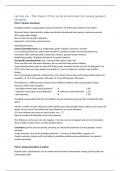Lecture 4a – The impact of the social environment on young people’s
sexuality
Part 1: Parents and peers
Ecological models, young people’s social environment all the layers influence each other
Structural family characteristics: single parenthood, educational level parents, profession parents,
SES, having older siblings.
But: no clear/strong link in literature.
Important: not structure, but processes!
Parenting processes:
General parenting factors (e.g. relationship quality (support, closeness, warmth)
It is a protective factor for: early sexual initiation, consistent condom- and contraceptive use,
interaction skills (communication, autonomy, esteem), positive sexual emotions.
Relationship quality global self-esteem sexual emotions
Sex-specific parenting factors (e.g. communication about (safe) sex)
There are links with safe sexual behavior, but no clear link with sexual initiation.
Communication about safe sex does NOT lead to more intention to have sex (Van de Bongardt et al,
2014). Also, there are many aspects to consider (!): yes/no, frequency, content, easy/comfort,
timing…
Peers increasingly important in adolescence: from whom do you learn most about relationships and
sexuality? 13,7y 41% parents, 33% peers 15,2y 28% parents, 48% peers
Peer influence, 3 different types of peer norms, different relations with young people’s sexual
behavior, which is the strongest?
- descriptive norms (peer sexual behavior) (.40)
- injunctive norms (peer sexual attitudes) adolescent sexual behavior (.22)
- peer pressure (.10)
Providing young people with the real statistics may be preventive, because they overestimate their
peers!
Parents as buffer for peer influence: parent-adolescent communication about (safe) sex decreases the
impact of peer norms and adolescent sexual behavior (or sexual intention).
if you estimate your peers as sexual active, you ..???
there is no effect of descriptive norms from parents
Peer influence is of course not only negative, it can be a source of support and correct information.
There is little research so for on these positive effects.
Conclusion: general and sex-specific parenting are important predictors of young people’s sexual
behavior.
As age increases peers increasingly important – as source of information, support, etc.
Parents and peers interact with each other in predicting adolescent sexual behavior (so: parents
remain important).
Part 2: Sexual education at school
Double Dutch: simultaneous use of condom and hormonal contraceptive (among youth usually the
contraceptive pill).





